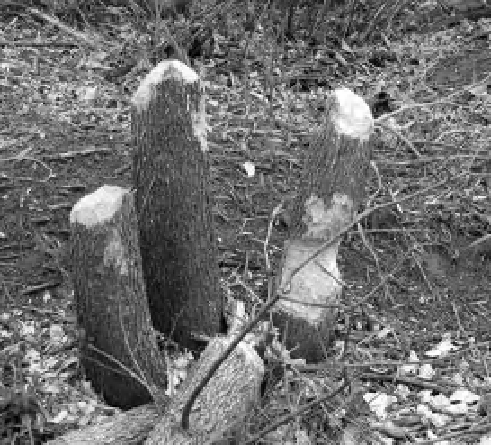Geoscience Reference
In-Depth Information
Figure 7-47.
Recently cut tree stumps and fresh wood
chips demonstrate the return of beaver in the central
Great Plains region. Photo by J.S. Aber; slough on the
l oodplain of the Cottonwood River valley, eastern
Kansas, United States.
Figure 7-48.
The Florida panther (
Puma concolor
coryi
) is in grave danger of becoming extinct. Adapted
from original photo by R. Cammauf; obtained from
Everglades NPS
(Animal and Plant Health Inspection Service
2005). Thousands were released into the wild in
the 1940s, when the nutria fur market collapsed.
Nutria were also widely distributed for weed
control by wildlife agencies and entrepreneurs.
Nutria have a high rate of reproduction and have
proliferated in the southeastern United States
along the Gulf and Atlantic coasts as well as the
Pacii c coast of Oregon and Washington. Their
preferred habitat is fresh-water marshes, where
they cause considerable damage by eating veg-
etation and burrowing into banks and levees.
This activity weakens the vegetative cover and
breaks up soil, thus contributing to loss of
coastal wetlands. Controlling nutria has proven
difi cult. Physical means, such as manipulating
water levels and protecting structures and veg-
etation, are costly and not always effective. Trap-
ping and killing is the only effective technique,
but requires a sustained effort over many years.
In Europe, attempts to eradicate nutria have
been underway since the mid-twentieth century,
and Great Britain succeeded in eliminating
nutria in the 1980s (Colona et al. 2003).
Zebra mussels (
Dreissena polymorpha
) rep-
resent one of the greatest aquatic invasions
http://www.nps.gov/ever/parknews/
evergladeswildlifeimages.htm
>
.
<
currently underway in North America. Zebra
mussels have triangular shells with distinctive
brown stripes, which give rise to the common
name (Fig. 7-49). They originated in drainage
basins of the Black and Caspian seas in central
and eastern Europe; from there they followed
shipping canals into non-native lakes and rivers
of western Europe in the eighteenth and nine-
teenth centuries (Murphy 2010). Zebra mussels
are i lter feeders, straining planktonic algae,
zooplankton, and other i ne food particles from
water, thus depleting food available for native
i sh and shelli sh. Like barnacles, they encrust
any available hard surface with their shells,
thereby damaging or destroying vessels and
water-handling structures. In Europe, they have
seriously impaired water supplies, hampered
shipping, and altered fresh-water ecosystems for
more than a century.
They i rst entered North America in 1988 at
Lake St. Clair, which connects Lake Erie and






